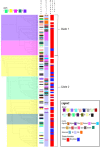The use of genome wide association methods to investigate pathogenicity, population structure and serovar in Haemophilus parasuis
- PMID: 25539682
- PMCID: PMC4532294
- DOI: 10.1186/1471-2164-15-1179
The use of genome wide association methods to investigate pathogenicity, population structure and serovar in Haemophilus parasuis
Abstract
Background: Haemophilus parasuis is the etiologic agent of Glässer's disease in pigs and causes devastating losses to the farming industry. Whilst some hyper-virulent isolates have been described, the relationship between genetics and disease outcome has been only partially established. In particular, there is weak correlation between serovar and disease phenotype. We sequenced the genomes of 212 isolates of H. parasuis and have used this to describe the pan-genome and to correlate this with clinical and carrier status, as well as with serotype.
Results: Recombination and population structure analyses identified five groups with very high rates of recombination, separated into two clades of H. parasuis with no signs of recombination between them. We used genome-wide association methods including discriminant analysis of principal components (DAPC) and generalised linear modelling (glm) to look for genetic determinants of this population partition, serovar and pathogenicity. We were able to identify genes from the accessory genome that were significantly associated with phenotypes such as potential serovar specific genes including capsule genes, and 48 putative virulence factors that were significantly different between the clinical and non-clinical isolates. We also show that the presence of many previously suggested virulence factors is not an appropriate marker of virulence.
Conclusions: These genes will inform the generation of new molecular diagnostics and vaccines, and refinement of existing typing schemes and show the importance of the accessory genome of a diverse species when investigating the relationship between genotypes and phenotypes.
Figures





References
-
- Rapp-Gabrielson V, Oliveira S, Pijoan C. Book of Swine. Volume Section II. 9. Oxford: Blackwell; 2006. Haemophilus parasuis; pp. 681–690.
-
- Kirkwood RN, Rawluk SA, Cegielski AC, Otto AJ. Effect of pig age and autogenous sow vaccination on nasal mucosal colonization of pigs by Haemophilus parasuis. J Swine Heal Prod. 2001;9:77–79.
Publication types
MeSH terms
Grants and funding
- BB/G019177/1/BB_/Biotechnology and Biological Sciences Research Council/United Kingdom
- BB/G019274/1/BB_/Biotechnology and Biological Sciences Research Council/United Kingdom
- BB/G003203/1/BB_/Biotechnology and Biological Sciences Research Council/United Kingdom
- BB/G020744/1/BB_/Biotechnology and Biological Sciences Research Council/United Kingdom
- BB/G018553/1/BB_/Biotechnology and Biological Sciences Research Council/United Kingdom
LinkOut - more resources
Full Text Sources
Other Literature Sources

